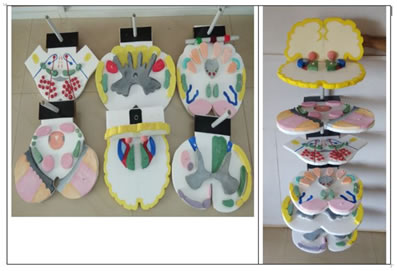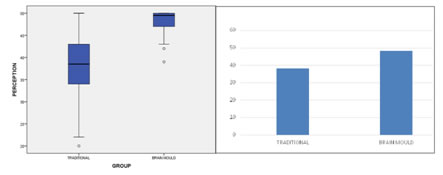|
Table of Content Volume 11 Issue 3 - September 2019
A comparative study of effectiveness of teaching CNS tracts by using pre-moulded parts of brain, needle/thread and traditional method of lecture-based teaching
Roshan S1, Shishirkumar2*, Shivarama CH3, Chethana Y K4, Nishitha5
1,2,3Associate Professor, 4,5Tutor, Department of Anatomy, Kanachur Institute of Medical Sciences, Mangalore
Abstract Background: Neuro-anatomy has been one of the toughest subject in terms of teaching. The tracts although considered simple, are a herculean task to remember. Adding fuel to fire, the old curriculum prescribes theory classes. So if the teacher is interested in explaining the topic practically, it is all the more exhausting to find good quality specimen. This study, although at nascent stage is a sincere attempt to find if the thermocol mould of brain can provide the desired results. Objectives: To study the effectiveness of needle/thread and pre-moulded brain parts method for teaching neuro anatomy in comparison with traditional lectures. To analyse the perception of the students towards learning of brain anatomy using needle/thread and pre moulded brain parts. Methods: This study was done in the Department of Anatomy, Kanachur Institute of Medical Sciences, Mangalore. The study was conducted from February 2019 to March 2019. One hundred students were selected by stratified randomization, equally divided into two groups and were considered for the study. Traditional lectures were taught to one group and the other group was taught using the brain mould and needle method. After the teaching by both methods MCQ test was conducted immediately and after 15 days, the scores were taken and unpaired t test was done. Paired t test for comparison of the before and after values in each group separately was also done. The perceptions of the students were taken by using a Likert scale which had pre-validated questionnaire. The scores were taken and the marks were compared using Mann Whitney U test and also unpaired t test. Results: Comparison of the MCQ scores between the two groups shows that MCQ score is higher in Brain mould group with a t value of -8.062 and is statistically significant with a p value of <0.001 Perception of students between two groups by using Mann Whitney U test, the Mean perception score in the traditional method was found to be 38.12 and the standard deviation was found to be 7.1. The p value was found to be <0.001. So there was a significant difference between the perception scores between the two groups. Conclusion: Brain mould and needle method appears to be a better choice to teach tracts in Neuro-Anatomy. Key Words: Brain mould, lectures, Needle and thread, teaching Neuro-anatomy.
INTRODUCTION Often after first year the knowledge of an undergraduate is somewhat dwindled1. According to a study post first year, considerable loss of subject knowledge has been documented2, In another study, surgery postgraduates were unable to identify the surgical planes in the initial period after joining3. So the teaching methodology should be such that the subject is remembered for a life-time by the students.4 Teaching syllabus for 1st year MBBS has been reduced to just ten months. Innovative teaching has become the need of the hour. Anatomy has always been more of practical subject and with lack of time; lectures have become a main stray of teaching. Lectures are preferred as larger groups can be covered and save valuable time but the question always remains of whether it is effective. There are some topics in Anatomy where practical approach is a must5,6. One such area is the Neuro-anatomy especially the tracts. It is a known fact that, in any subject if continuity is maintained then it becomes easier to teach the students. But in a subject like tracts in neuro-anatomy, it becomes very difficult for the teachers and students to keep up with continuity as it is not easily visualised. Also teaching neuro-anatomy has been compartmentalised, so this study puts in a sincere effort to make a continuous visualisation to teach 1st year MBBS students effectively by using basic materials that is commonly available. So goal of teaching should be to create an environment to learn effectively7.
MATERIALS AND METHODS
1st MBBS students of 2018 batch
Those students who have not given valid consent and who were absent for one class or for assessment.
Statistical Analysis Statistical significance of comparison of post test scores obtained immediately by two teaching learning methods was analysed using unpaired t test. Statistical significance of comparison of post test scores obtained after 15 days by two teaching learning methods was analysed using unpaired t test. Paired t test was used to analyse the MCQ scores between the immediate scores and the scores obtained after 15 days. Descriptive data was expressed as percentage for perception. Mann Whitney U test was used to compare perception between two groups. Also unpaired t test was done to analyse the perception between two groups. Image 1: Sections of brain made of thermocol ETHICAL CLEARANCE The study proposal was approved by the Institutional Ethics Committee of Kanachur Institute of Medical Sciences on 13th Feb 2019 with reference number 3/FEB/IEC/2019.
OBSERVATIONS AND RESULTS
Table 1: Independent t test to compare between the two groups
MCQ scores between the two groups shows that MCQ score is higher in Brain mould group and is statistically significant with a p value of <0.001. MCQ-after between the two groups shows that MCQ-After is higher in brain mould group and is statistically significant with a p value of <0.001 Table 2: Paired t test for comparison of the before and after values in each group separately
Table 4: Independent t test to compare perception between the two groups
Perception between the two teaching methods shows that perception of learning is higher in brain mould group and is statistically significant with a p value of <0.001 Graph 1 Graph 2 Graph 3 Graph 4 Graph 5 Graph 1: Mean MCQ Scores immediately and after 15 days; Graph 2: Mean MCQ score difference; Graph 3: Mean MCQ score immediate and after 15 days; Graph 4: Mann Whitney U test between the perceptions score based on the Likert’s Scale; Graph 5: Comparison of the Mean Perception Scores between the two groups using Unpaired t test DISCUSSION As shown by the results, this innovative technique of teaching CNS tracts by using brain mould made of thermocol and needle and thread made significant effect on medical students. Previously also different learning aids were used and updated to enhance student learning. Though learning is individual, the learning aids help to evoke student interest. E. Rathenberg has pointed out that teaching aids can make teaching interesting by reproducing reality in situations where exposure to actual reality is not possible or still premature10. In our study results involving, Comparison of the Perception between the two groups by unpaired t test shows that Perception is higher in Brain mould group with a t value of -9.603 and is statistically significant with a p value of <0.001. Comparison of the MCQ between the two groups shows that MCQ is higher in Brain mould group with a t value of -8.062 and is statistically significant with a p value of <0.001. Comparison of the MCQ-after between the two groups shows that MCQ-after is higher in Brain mould group with a t value of -9.531 and is statistically significant with a p value of <0.001. Comparison of the MCQ difference between the two groups shows that MCQ difference is higher in traditional group with a t value of 0.804 and is statistically non-significant with a p value of 0.424Also in this study, Traditional Method on comparison of the mean values of MCQ and MCQ-AFTER 15 days by paired t test shows that the mean values of MCQ is higher with a difference of 2.08 is statistically significant with a p value of <0.001. Brain mould on comparison of the mean values of MCQ and MCQ-AFTER the mean values of MCQ is higher with a difference of 1.72 is statistically significant with a p value of <0.001. In our study by using Mann Whitney U test, the Mean perception score in the traditional method was found to be 38.12 and the standard deviation was found to be 7.1. The maximum score was 50 and the median score was noted to be 38.5. The Minimum score 20.In the Brain mould method the mean was found to be 48.32. The standard deviation was found to be 2.44. The maximum score was 50 and the median was found to be 49.5. The minimum score was 39. The p value was found to be <0.001. So there was a significant difference between the perception scores between the two groups. Our study stands in agreement with the study conducted by Anita Herur et al8. According to their study they found a significant difference between the normal class teaching Group and brain model by play dough and copper wire method. In their study they conducted the test immediately, after 15 days and repeated after 30 days. They found the relation to be significant in all the three scenarios. In another study done by Daw Khin Saw Naing et al9 brain models made of plastic sheets and LED lights as tracts were used to teach undergraduate students. In their study Comparison of post test scores by both methods showed significantly greater score in test group compared with control group. So our study is like hand in glove with the above studies, which implies that simpler innovative method in teaching Neuro anatomy is more effective than traditional lecture method.
CONCLUSION This study proves that the tracts can be actually made easy to students by using brain section moulds so that they remember for a very long time. The study also proves that cognitive included with psychomotor skill is very effective for teaching Neuroanatomy.
RECOMMENDATIONS The Brain mould and needle method is the better way to teach the tracts in Neuro-Anatomy. This can be inducted in the syllabus so as to be easy for the students to understand and also help to retain the knowledge for a long time.
LIMITATIONS Time was restricted and the study had to be completed in 2 months so cross over was done only to give the students an equal opportunity.
REFERENCES
|
|
|||||||||||||||||||||||||||||||||||||||||||||||||||||||||||||||||||||||||||||||||||||||||||||||||||||||||||||||||||||||||||||||||||||||||||||||||||||||||
 Home
Home



